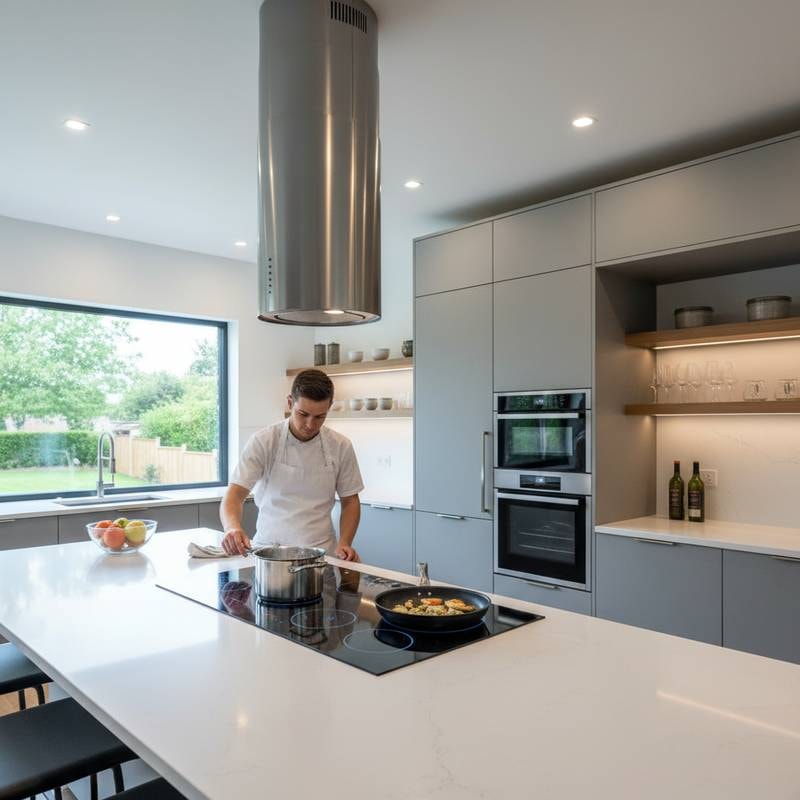Why Induction Cooktops Outperform Gas Stoves
Professional chefs on television often demonstrate remarkable speed in preparing meals, moving seamlessly from ingredients to finished dishes. A noticeable shift appears in their choice of equipment: many now prefer induction cooktops over traditional gas stoves. This preference stems from multiple advantages, including efficiency, safety, and aesthetic appeal. Induction technology proves both practical and accessible, making it a compelling option for home kitchens.
Achieving Rapid Heating and Precise Temperature Management
Induction cooktops excel in delivering immediate heat directly to the cookware through electromagnetic fields. Unlike gas flames that require time to build intensity or electric coils that need to warm up, induction activates instantly upon placing compatible pots or pans on the surface. This feature proves invaluable during time-sensitive cooking tasks, such as professional shoots or busy family dinners.
Temperature adjustments occur with equal responsiveness. Reducing the heat level results in quick cooling, which supports delicate processes like simmering sauces or melting chocolate without scorching. Even novice cooks benefit from this precision, as it minimizes the risk of overcooking and encourages experimentation with recipes.
Maximizing Energy Use for Cost Savings
Induction systems heat only the cookware, bypassing the surrounding air and minimizing energy loss. This targeted approach contrasts with gas stoves, which disperse heat broadly and contribute to higher utility expenses over time. Homeowners on modest budgets or those planning extensive renovations find these savings particularly appealing.
The cooktop surface remains cooler to the touch during operation, reducing the overall heat output into the kitchen environment. This efficiency eases the burden on cooling systems during warmer months and maintains a more comfortable cooking space. Families experience fewer instances of overheated rooms, enhancing the overall pleasure of meal preparation.
Promoting a Healthier and Safer Cooking Environment
Gas stoves produce combustion byproducts, including nitrogen dioxide, which can accumulate in indoor air and affect respiratory health. Subtle odors or residue around burners signal these emissions, posing ongoing concerns for households. Induction eliminates open flames and gas release entirely, resulting in purer air quality.
Safety extends to physical interactions with the equipment. The surface heats only where cookware contacts it, allowing incidental touches elsewhere without risk of burns. This design suits homes with young children or high-traffic kitchens. Additionally, the smooth glass top simplifies maintenance, as spills evaporate quickly without adhering, requiring only a damp cloth for cleaning.
Enhancing Kitchen Aesthetics and Layout Options
Induction cooktops integrate seamlessly into diverse countertop materials, from sleek quartz to durable concrete, fostering a contemporary appearance. Designers appreciate the flush installation that avoids visible gaps or protrusions common with gas setups. This versatility suits various spaces, including compact apartments or expansive gourmet areas.
Affordability spans a wide range. Portable single-burner models begin at approximately sixty dollars, ideal for renters or supplemental use. Built-in multi-zone units for full kitchen integration start around eight hundred dollars and extend to two thousand five hundred dollars for premium features like touch controls and smart connectivity. Selecting the right model involves considering cookware compatibility, typically requiring ferromagnetic materials such as cast iron or stainless steel.
Simplifying the Switch from Gas to Induction
Transitioning from a gas system requires minimal disruption in most cases. Qualified electricians often complete outlet upgrades in a single visit, with costs varying by location but generally under five hundred dollars. Local incentives, such as rebates through electrification initiatives, further offset expenses and encourage adoption.
For those in rental properties or temporary setups, countertop induction units offer plug-and-play convenience. These devices connect to standard outlets and provide full functionality without altering built-in infrastructure. Testing compatibility with existing pots and pans before purchase ensures a smooth integration.
Embracing Induction for Everyday Culinary Success
Adopting induction transforms routine cooking into a more efficient and enjoyable process. The combination of rapid response, clean operation, and stylish integration elevates home kitchens to professional standards. Home cooks gain confidence through reliable performance, while the technology supports sustainable practices by reducing energy consumption.
Consider evaluating your current setup against these benefits to determine readiness for an upgrade. Portable options allow trial without commitment, helping users experience the advantages firsthand. Ultimately, induction empowers better meals with less effort, fostering creativity and comfort in every cooking session.









